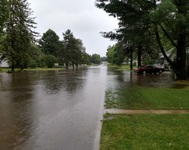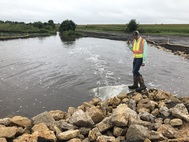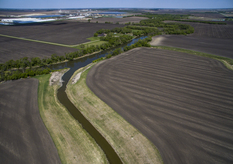
The Lessard-Sams Outdoor Heritage Council expects to open its annual funding round April 1. Proposals for funding 2020-21 projects will be due May 31. The council expects about $100 million to be available for projects that protect, restore and enhance wetlands, prairies, forests, and habitat. This estimate may be revised after November 2019. See the full request for proposals on the council website for details.
The council makes annual recommendations to the Minnesota Legislature on appropriations from the Outdoor Heritage Council, which is funded by the Clean Water, Land and Legacy Amendment.
|
The Minnesota Department of Agriculture (MDA) is seeking proposals for research related to clean water in agricultural areas of the state. The goal is to fund research that improves water quality in Minnesota by evaluating and promoting agricultural practices and technologies. The deadline for submitting proposals is April 12.
For more details see the announcement posted in the March 11 edition (page 1075) of the State Register. To get a copy of the full document with the research priorities, send an email request to Aicam Laacouri, Clean Water Research Coordinator, at Aicam.Laacouri@state.mn.us. For more information about MDA’s Clean Water Research Program and to learn about previously supported research projects see MDA’s Clean Water Research Program webpage.

With spring flooding already occurring in some parts of Minnesota, now is a good time to tap into response resources, especially for those who live in flood-prone areas. State emergency management officials have been making plans, and urge the public to check out this information:
For those in rural areas or operating feedlots, the MPCA recommends simple things to minimize pollution threats.
- Secure all propane and liquid fuel tanks so they will not tip over or float away in floodwaters. If possible, liquid fuel tanks should be emptied by your petroleum provider until floodwaters recede.
- Move household and farm chemicals to an area that is safe from floodwaters. If that is not possible, make sure they are in secure containers that will not leak, rupture or float off.
Smaller livestock operations that spread solid manure must ensure that it doesn’t run off with snowmelt flowing to surface waters. If possible, farmers should refrain from spreading manure during periods of rapid snow melt.
In addition to water damage, flooded basements are often contaminated by spills of household chemicals normally stored in them, such as paint, drain cleaner, and varnish. If possible, before a flood, move these items from your basement to a secure location, or if you no longer need them, take them to a county household hazardous waste facility.
|
After research showed low rates of fish tumors and other deformities in the St. Louis River Area of Concern (AOC), the U.S. Environmental Protection Agency (EPA) has agreed to remove an impairment for the area. Based on fish sampling in 2011, 2013 and 2015, Minnesota and Wisconsin recommended removing the Fish Tumors and Other Deformities Beneficial Use Impairment. This accomplishment is another step toward the AOC’s entire delisting, which is targeted for 2025.
The research on White Sucker fish in the St. Louis River AOC showed low rates of fish tumors and other deformities. Evidence confirmed that the tumor incidence rate was not significantly different between the river and Lake Superior. Further, the St. Louis River AOC tumor rates were lower than other studied sites in the Great Lakes. The age and gender of the fish were found to be more important factors for fish tumor development.
The St. Louis River AOC one of 43 designated in 1987 as the most highly contaminated areas in the Great Lakes. This work was included in the St. Louis River AOC Remedial Action Plan and was funded primarily by the federal Great Lakes Restoration Initiative.
The primary partners involved in this work included the Fond du Lac Band of Lake Superior Chippewa, Minnesota Department of Natural Resources, Minnesota Pollution Control Agency (MPCA), U.S. EPA, and the Wisconsin Department of Natural Resources.

Landowners and producers are working voluntarily to reduce pollutants in the Cedar River and its tributaries in southern Minnesota. And more of those practices are needed to help streams and lakes in the watershed, according to two draft studies by local partners and the MPCA. The MPCA invites comments on the studies through April 3.
Over the past decade, projects on farms and throughout small drainage areas have helped to reduce erosion and improve water quality.
One such project, led by the Cedar River Watershed District, consists of two areas to temporarily hold back stormwater that would normally flush pollutants to Dobbins Creek, a tributary to the Cedar River. Known as “Dobbins 1,” the $1.5 million project took more than 2 years to plan and involves multiple landowners.
After a big rainfall, two earthen dams will detain stormwater over more than 50 acres – larger than Austin’s East Side Lake –helping improve water quality and reduce flooding. The project is expected to reduce peak flood flows by 82 percent immediately downstream from its structures, keeping about 134 tons of sediment and 218 pounds of phosphorus per year out of Dobbins Creek.
Additional projects will help address the major issues in the Cedar River watershed identified by the studies: Excessive levels of sediment, bacteria and nutrients. High levels of these pollutants can hurt aquatic life and recreation like fishing and swimming.
The studies also identified these additional stressors, often related to elevated pollutant levels, to fish and bug populations:
- Lack of habitat
- Low dissolved oxygen
- Changes in stream flows
In addition, nitrogen is a growing concern in this watershed. Monitoring shows a significant increase in nitrogen levels in both the long-term and short-term. The Cedar River in Minnesota has some of the highest nitrogen concentrations in the state.
Several common strategies would help improve water quality throughout the Cedar watershed, including:
- Improve soil health
- Controlled drainage and water storage areas
- Improve habitat through buffers and other practices
- Managing stormwater in urban areas.
- Upgrading rural septic systems.
Because most of the land in this watershed is used for agriculture, that is where most of the strategies need to be implemented.
Open for comment are the Total Maximum Daily Load (TMDL) study and the Watershed Restoration and Protection Strategies (WRAPS) report. They are companion documents that quantify pollutant levels, identify pollution sources, propose ways to return water quality to an acceptable level and describe protection strategies to ensure continued high quality water resources.
Comments on the draft reports should be sent to Bill Thompson, MPCA project manager, 18 Wood Lake Drive S.E., Rochester, MN 55904; or by email, bill.thompson@state.mn.us. For more information, call him at 507-206-2627. Comments must be received by 4:30 p.m. on April 3.
Written comments must include a statement of your interest in the report (specify which report, WRAPS or TMDL), a statement of the action you wish the MPCA to take, including specific references to sections of the draft report you believe should be changed, and specific reasons for your position.
|

The fish are doing OK, and continued efforts are needed to meet the other challenges facing the Red River of the North, according to a study by the MPCA. This is Minnesota’s first comprehensive study on the Red River’s water quality that looks at the health of insects and fish that live in the river, starting from near Breckenridge to the Canadian border.
The river forms the border between Minnesota and North Dakota and drains roughly 40,000 square miles in northwest Minnesota and northeast North Dakota.
Monitoring shows the Red River and its tributaries carry too much sediment to meet Minnesota standards designed to protect fish and other aquatic life. Some stretches are impaired for swimming due to high levels of bacteria. Generally speaking, fish and aquatic insect communities are doing OK, but could be more diverse and healthier if the water were clearer.
Many of the Red River’s problems can be traced to flow levels. Too much water is flowing through tributaries and the Red River during spring runoff and rain events, and at other times, there is too little or no water in the tributaries. And there’s more rain, more artificial drainage, and not enough places to store excess water.
The high flows bring pollutants like sediment, nutrients and bacteria with them. The pollutants hurt fish and other aquatic life, and can also affect recreation. The high nutrient levels contribute to the severe algae downstream in Lake Winnipeg on the Canadian side of the basin.
Climate change is causing more intense rain events, but flow rates have increased five times faster than precipitation. One reason: The Red basin is one of the most artificially drained areas in the world, with a vast network of ditches, altered streams and, increasingly, agricultural tiling systems. The drainage is so effective that many streams run dry in summer, forcing fish and other river life to move downstream or die.
“This is one of the most productive farming areas in the world, and we want our farmers to remain productive,” says Jim Ziegler, MPCA Detroit Lakes Regional Manager. “Farmers, watershed districts, state agencies, and many other organizations are working together to improve and protect water quality while still maintaining high levels of agricultural productivity.”
(See an example of these efforts in the story below.)
Other highlights of the report:
- Nitrogen levels in the river are creeping up in a few areas. Several communities draw their drinking water from the river, and nitrogen can be a health risk to humans. It can also be toxic to fish.
- More changes are needed to help the fish population, including preventing extreme fluctuations in flow, reducing pollutants, and increasing habitat. As the river flows north through more cultivated and drained land, habitat declines along with the number of fish species, from 22 near the headwaters to 13 near the Canadian border.
The report recommends continuing actions that can protect and restore water quality, including:
- Invest in water storage, such as methods that filter and store rainwater, leading to cleaner water in rivers
- Improve fertilizer and manure management
- Build soil health; boosting soil health also helps the land absorb water during heavy rains
- Invest in wastewater treatment – communities in the basin are working to reduce the phosphorous they discharge to the river
- Prevent runoff with flood mitigation projects; runoff flushes pollutants from the land
To see the full report, visit the MPCA web site.
|
Landowners and farmers in Wilkin County in western Minnesota are building on past water quality efforts by backing a new project to modernize a drainage system that has not been improved significantly in more than a hundred years. A report shows the outdated system served by ditches 9 and 10 suffers from:
- Uncontrolled flows that cause excessive erosion and sediment transport.
- Improper culvert sizing that causes unnecessary flooding and downstream impacts
- Excessive spoil bank heights that force floodwaters over a major highway, posing a safety hazard
- High velocity areas that promote channel erosion
Chad Engels, engineer for the Bois de Sioux Watershed District, says when designed correctly, ditch improvement projects can help control flooding and improve water quality by conveying smaller, more frequent summer rainfall events in a manner that results in minimal crop loss. Larger flows, like those resulting from spring snow melts or heavy summer rain storms, can also be controlled if a project is designed correctly.
“The secret is to size channels and culverts just large enough to pass the smaller flows,” Engels says. “When flows exceed the design flow, excess water is pushed out of the channel and goes into floodplain storage in the adjacent field. The culvert is being used to meter the flow. The most benefit is seen when existing oversized bridges are replaced with smaller culverts.”
The project’s estimated cost to landowners is about $2 million. The Minnesota Board of Soil and Water Resources will provide a $60,000 grant in coordination with the Wilkin County SWCD.
Construction should begin this summer.

As Minnesota’s weather patterns change, bringing long periods of drought and flooding rains, the need for resilient yards is increasing. This is especially true for urban areas where impermeable surfaces retain the sun’s heat while contributing runoff to lakes and streams. Resilient yards help shed and shade the sun’s heat, soak up and infiltrate stormwater, and use the stormwater to cool the surrounding landscape.
Metro Blooms, a non-profit group that coordinates the Blue Thumb program, is offering three types of workshops at many places and times this spring:
- Resilient Yard Workshops (2.5 hours)
- Turf Alternatives Workshops (1.5 hours)
- Healthy Soils Workshop (1.5 hours)
All workshop attendees receive information about installation cost-share programs and Blue Thumb resources to help get a project in the ground.
Workshops are scheduled for 11 locations in the Twin Cities through June 6. For details and registration, visit the Metro Blooms workshop webpage or call 651-699-2426. The cost is $15 per household, though some locations have no fee because of local sponsorship.
|
|